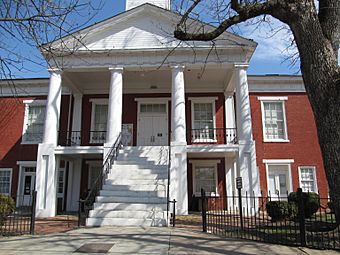Pittsylvania County Courthouse facts for kids
|
Pittsylvania County Courthouse
|
|

Pittsylvania Courthouse in 2013
|
|
| Location | US 29, Chatham, Virginia |
|---|---|
| Area | 0.5 acres (0.20 ha) |
| Built | 1853 |
| Architect | Shumaker, L.A. |
| Architectural style | Colonial Revival, Italianate |
| NRHP reference No. | 81000643 |
Quick facts for kids Significant dates |
|
| Added to NRHP | October 29, 1981 |
| Designated NHL | May 4, 1987 |
The Pittsylvania County Courthouse is a very old and important building in Chatham, Virginia. It was built in 1853. This building was the third courthouse for Pittsylvania County, Virginia. It is designed in a style called Greek Revival, which looks like ancient Greek temples.
In 1987, this courthouse was named a National Historic Landmark. This means it is a place with special historical importance to the United States. It became famous because of events that led to a big case called Ex parte Virginia at the U.S. Supreme Court. This case helped make sure that everyone, no matter their background, was treated fairly in the legal system.
Contents
About the Courthouse Building
The Pittsylvania County Courthouse is located on the east side of US Business Route 29. It sits at the corner of Bank Street. The oldest part of the building was finished in 1853. It faces west. A newer part of the building was added later, extending to the east.
The courthouse is a two-story building made of brick. It was designed by L.M. Shumaker. The building mixes two styles: Classical and Italianate. It has a grand front porch, called a portico, with four tall, fluted columns. On top of the building, there is a tall tower called a cupola. This cupola holds a bell and a clock.
History of the County and Town
Both Pittsylvania County and the town of Chatham were named after William Pitt, 1st Earl of Chatham. He was a very important leader in the British government when the county was formed in 1767.
The courthouse you see today replaced an earlier building from 1783. That older building was located one block west. The court was moved to Chatham from Callands in 1777.
A Landmark Civil Rights Case
In 1878, a judge named J.D. Coles was arrested. He was accused of breaking the Civil Rights Act of 1875. This law was made to protect the equal rights of all citizens. The judge was accused of not allowing African Americans to be chosen for grand juries and trial juries. A jury is a group of citizens who help decide court cases.
Judge Coles argued that his rights were being violated. His case went all the way to the U.S. Supreme Court. This important case was called Ex parte Virginia.
The Supreme Court's Decision
The Supreme Court decided against Judge Coles. They ruled that the Equal Protection Clause of the Fourteenth Amendment to the United States Constitution meant that states and their officials had to treat everyone equally. This included how they chose people for juries.
This decision was a big victory for people who wanted equal rights for all. It helped make sure that state laws and actions by state officials could not unfairly treat people differently. The Pittsylvania County Courthouse played a role in this important step toward fairness in the American legal system.



